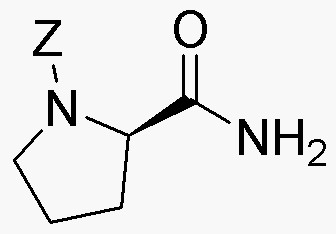Z-D-proline amide is widely utilized in research focused on
- Peptide Synthesis: This compound serves as a valuable building block in the synthesis of peptides, particularly in the development of cyclic peptides that exhibit enhanced stability and bioactivity.
- Drug Development: It is employed in the pharmaceutical industry for designing new drugs, especially those targeting neurological disorders, due to its ability to mimic natural amino acids.
- Biochemical Research: Researchers use Z-D-proline amide to study protein folding and stability, providing insights into diseases related to protein misfolding.
- Chiral Catalysis: This chemical acts as a chiral auxiliary in asymmetric synthesis, facilitating the production of enantiomerically pure compounds, which are crucial in drug formulation.
- Material Science: It finds applications in the development of novel materials, particularly in creating hydrogels that can be used in drug delivery systems.
General Information
Properties
Safety and Regulations
Applications
Z-D-proline amide is widely utilized in research focused on
- Peptide Synthesis: This compound serves as a valuable building block in the synthesis of peptides, particularly in the development of cyclic peptides that exhibit enhanced stability and bioactivity.
- Drug Development: It is employed in the pharmaceutical industry for designing new drugs, especially those targeting neurological disorders, due to its ability to mimic natural amino acids.
- Biochemical Research: Researchers use Z-D-proline amide to study protein folding and stability, providing insights into diseases related to protein misfolding.
- Chiral Catalysis: This chemical acts as a chiral auxiliary in asymmetric synthesis, facilitating the production of enantiomerically pure compounds, which are crucial in drug formulation.
- Material Science: It finds applications in the development of novel materials, particularly in creating hydrogels that can be used in drug delivery systems.
Documents
Safety Data Sheets (SDS)
The SDS provides comprehensive safety information on handling, storage, and disposal of the product.
Product Specification (PS)
The PS provides a comprehensive breakdown of the product’s properties, including chemical composition, physical state, purity, and storage requirements. It also details acceptable quality ranges and the product's intended applications.
Certificates of Analysis (COA)
Search for Certificates of Analysis (COA) by entering the products Lot Number. Lot and Batch Numbers can be found on a product’s label following the words ‘Lot’ or ‘Batch’.
*Catalog Number
*Lot Number
Certificates Of Origin (COO)
This COO confirms the country where the product was manufactured, and also details the materials and components used in it and whether it is derived from natural, synthetic, or other specific sources. This certificate may be required for customs, trade, and regulatory compliance.
*Catalog Number
*Lot Number
Safety Data Sheets (SDS)
The SDS provides comprehensive safety information on handling, storage, and disposal of the product.
DownloadProduct Specification (PS)
The PS provides a comprehensive breakdown of the product’s properties, including chemical composition, physical state, purity, and storage requirements. It also details acceptable quality ranges and the product's intended applications.
DownloadCertificates of Analysis (COA)
Search for Certificates of Analysis (COA) by entering the products Lot Number. Lot and Batch Numbers can be found on a product’s label following the words ‘Lot’ or ‘Batch’.
*Catalog Number
*Lot Number
Certificates Of Origin (COO)
This COO confirms the country where the product was manufactured, and also details the materials and components used in it and whether it is derived from natural, synthetic, or other specific sources. This certificate may be required for customs, trade, and regulatory compliance.


